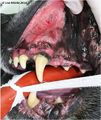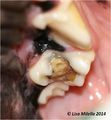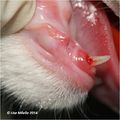Difference between revisions of "Dentistry Quiz 5"
Jump to navigation
Jump to search
| (2 intermediate revisions by the same user not shown) | |||
| Line 1: | Line 1: | ||
| − | + | <gallery> | |
| − | + | File:Dentistry Quiz 5.jpg|<center>'''A'''</center> | |
| − | + | File:Dental Caries.jpg|<center>'''B'''</center> | |
| − | + | File:Dentistry Quiz 5b.jpg|<center>'''C'''</center> | |
| + | File:Tooth resorption 3.jpg|<center>'''D'''</center> | ||
| + | File:Dentistry Quiz 5e.jpg|<center>'''E'''</center> | ||
| + | </gallery> | ||
<WikiQuiz | <WikiQuiz | ||
questionnumber="5" | questionnumber="5" | ||
| Line 10: | Line 13: | ||
choice3="C" | choice3="C" | ||
choice1="A" | choice1="A" | ||
| + | choice5="E" | ||
correctchoice="1" | correctchoice="1" | ||
| − | feedback1="'''Correct!''' | + | feedback1="'''Correct!''' This is a dog with gingivitis and chronic ulcerative paradental stomatitis due to contact of the oral mucosa with plaque. If the teeth can be kept clean, they do not need to be extracted. [[Exodontics|WikiVet Article: Exodontics]]" |
| − | feedback4="'''Incorrect.''' | + | feedback4="'''Incorrect.''' This is a cat with resorptive lesions. Extraction is indicated here. [[Exodontics|WikiVet Article: Exodontics]]" |
| − | feedback2="'''Incorrect.''' | + | feedback2="'''Incorrect.''' This tooth is affected by caries decay. Tooth extraction is suitable treatment option. [[Exodontics|WikiVet Article: Exodontics]]" |
| − | feedback3="'''Incorrect.''' | + | feedback3="'''Incorrect.''' This is a fractured mandibular canine. The pupl had started to become necrotic and thus extraction is a suitable treatment option. [[Exodontics|WikiVet Article: Exodontics]]" |
| − | + | feedback5="'''Incorrect.''' There are fractured and discoloured deciduous teeth present that will not fall out themselves. Extraction is indicated in this case. [[Exodontics|WikiVet Article: Exodontics]]" | |
image= ""> | image= ""> | ||
</WikiQuiz> | </WikiQuiz> | ||




